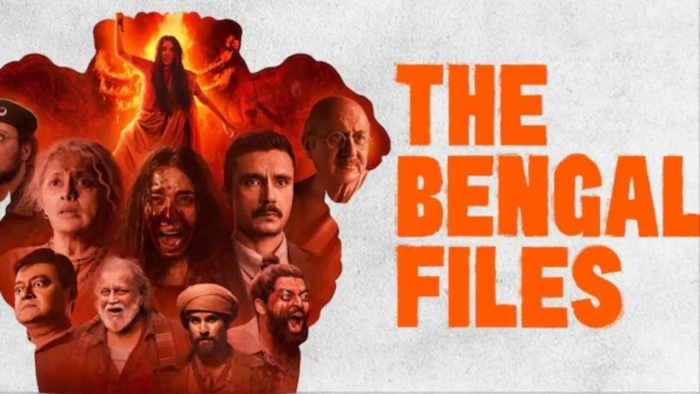I watched Vivek Agnihotri’s The Bengal Files on the evening of its release last Friday. It was a private screening organized by a celebrity eye surgeon in Mumbai for 300 friends and family members. Naturally, the theater was housefull.
I watched it again two days later, on Sunday afternoon, at a public show, not a sponsored or private one. The theater was housefull again, and I made a reel of it that went viral on social media.
I watched it a third time yesterday, Thursday, at a late evening show. The audience was about 50%, with half of them evidently affluent and cultured citizens, going by their appearance even from a distance. The rest half were mostly smart Mumbaikars in their 20s and 30s.
Even after watching it thrice, the reaction was one of shock, stunned silence, and awe. The words “Wow, Vivek!” escape you, and you’re left wondering why, in nearly eight decades of independence, no filmmaker had made a film like this before.
When Vivek Agnihotri’s ‘The Tashkent Files’ was released, opponents didn’t launch any pre-release propaganda against it. With ‘The Kashmir Files’, there was significant opposition after its release, but not before. However, with ‘The Bengal Files’ opposition began even before the trailer was released. After the trailer, opponents created an atmosphere suggesting the film’s release would spark Hindu-Muslim riots across the country. Actually they feared it might become a superhit like ‘The Kashmir Files’ which grossed ₹350 crore against a ₹15 crore budget.
After ‘The Bengal Files’ released, anti-national elements in the media and social media unleashed a barrage of negative reviews. On Twitter and Facebook, some people started criticizing the film without even watching it. Never before has a Hindi film faced such widespread and intense negative propaganda.
Box office figures don’t prove a film’s impact, greatness, quality, or even popularity. A prime Hollywood example is The ‘Shawshank Redemption’ based on a short story by Stephen King, who is often praised as the modern Charles Dickens. This prison drama was declared a flop upon release in the 1990s. Yet, today, it consistently ranks second in Hollywood’s top ten films, often just behind ‘The Godfather’ based on Mario Puzo’s best selling novel.
Hindi cinema has countless similar examples. Guru Dutt’s ‘Kaagaz Ke Phool’ and Raj Kapoor’s ‘Mera Naam Joker’ were box office failures that bankrupted their makers. Today, they’re cult classics, counted among the finest Hindi films. Everyone says they were ahead of their time, and audiences weren’t ready. Yash Chopra’s multi-starrer ‘Silsila’ despite superhit songs, was a flop but is now a cult classic. There are many such cases.
‘The Bengal Files’ is estimated to have been made on a ₹35–40 crore budget. Industry sources say its first week’s box office collection hasn’t reached ₹15 crore. In India, it has earned around ₹11–12 crore so far, with overseas collections around ₹2.5 crore.
While these figures are certainly disappointing, many recent hit films, like ‘Jawan’ have inflated box office numbers to mislead audiences. Vivek Agnihotri’s films don’t practice such manipulation.
If a film made for ₹35 crore earns ₹35 crore, it doesn’t mean it breaks even. From the collection, entertainment tax goes to the government first, then theater owners take their share. After other expenses, the distributor gets a cut. Only then do producers get what’s left, from which production costs are deducted to calculate profit, which is then taxed.
Generally, a ₹35 crore film needs to collect around ₹70 crore to break even. Only after that the producers start seeing profits.
The OTT rights for ‘The Bengal Files’ have likely been sold, but the amount isn’t public yet. Even with that, it seems unlikely the producers will recover their investment. Producers Abhishek Agarwal and the Agnihotri couple will likely have to share the losses. Let us pray that doesn’t happen.
Vivek Agnihotri has said in interviews that ‘The Bengal Files’ was funded by profits from ‘The Kashmir Files’. If the money invested in ‘The Bengal Files’ doesn’t return, let alone profit, can Vivek continue making films? He may have immense courage, but will others financially back his projects? Vivek Agnihotri must not be discouraged. His team and supporters shouldn’t abandon him. Ups and downs are part of the journey.
A film flopping at the box office doesn’t make its creator a failure. If Vivek Agnihotri only cared about money, he could’ve made films like Karan Johar or Priyadarshan make, and bought villas in Dubai or Switzerland. He has the talent, skill, and acumen for it. But he aims to awaken the viewer through cinema. Films like ‘The Kashmir Files’, ‘The Vaccine War’ and ‘The Tashkent Files’ have sparked awareness among audiences. After watching ‘The Bengal Files’ for the third time, I overheard college students in the theater foyer. One asked, “Really? Did ‘they’ get Shastriji killed?” Vivek’s films are opening India’s eyes, prompting questions.
Few knew about Direct Action Day or the Noakhali Hindu massacre, as those pages were erased from school and college curricula. Such films bring these truths to light. Before ‘The Kashmir Files’, only a handful knew how Kashmiri Hindus were displaced and how Kashmir was deliberately distanced from India. Through the film this knowledge reached crores.
Similarly, ‘The Vaccine War’ revealed how India stood firm against the greed of multinational pharma companies like Pfizer during COVID, saving economic losses and lives that would have been lost because of a compromised vaccine that was outright wrong for the India’s climate. You might find this in obscure reports or books, but as an average citizen, you wouldn’t read it. Now you have a crystal clear picture in a 2.5 hour film.
The same applies to Lal Bahadur Shastri’s suspicious death in Tashkent. Official records were tampered with, and later the controversy was buried. Without Vivek’s film, most Indians would remain unaware. Only when filmmakers like him make movies about the deaths of scientists like Vikram Sarabhai or Homi Bhabha will we get closer to the truth.
Vivek Agnihotri made a low-budget film, ‘Buddha in a Traffic Jam’ over a decade ago, addressing urban Naxals, the educated city elites masquerading as philanthropists while fueling Maoist and Naxal violence in India’s hinterlands.
Borrowing a famous Hindi cinema dialogue, we can say: ‘The Bengal Files’ hasn’t flopped; films like ‘The Bengal Files’ do not flop.
Making such films require courage to risk not just reputation but one’s life itself. It involves staking crores, not lakhs, and enduring losses while knowing surely that your opponents will attack you- in success or failure. It demands faith in the philosophy of Karmanye Vadhikaraste (do your duty, don’t worry about results).
Films like ‘The Bengal Files’ must be made. Fear of box office failure shouldn’t bury such subjects in obscurity. If a leftist or secular film flopped, would they focus on its collections or praise the director’s creativity and courage?
Had ‘The Bengal Files’ earned as much as ‘The Kashmir Files’ it would’ve inspired other filmmakers and financiers. The massive success of ‘The Kashmir Files’ led to many more such films- Ekta Kapoor produced The ‘Sabarmati Report’ and Vipul Amrutlal Shah produced ‘The Kerala Story’. Dozens of smaller films emerged due to the environment created by ‘The Kashmir Files’.
There’s a difference between good, truthful films and commercially successful ones. Not all good films make money, and not all profitable films are worth watching. Yes, it hurts when good filmmakers suffer losses, not just financial loss, but also the non-acknowledgement of their creativity.
Yet, this pain must be borne by the creator, their team, and millions of fans like us. We must console ourselves that, like ‘Kaagaz Ke Phool’, ‘Mera Naam Joker’, ‘Silsila’ or ‘The Shawshank Redemption’, ‘The Bengal Files’ is going to be celebrated as a cult classic for much longer than its theatrical release. And we’ll take pride in saying: ‘We watched it once (or even three times) when it was released’.
The above article was originally published in OpIndia Gujarati. Click here to read the Gujarati version.












